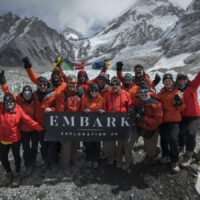Climbing Outside the Country 101
05.07.2012
(This article appears in the May/June issue of Mountaineer Magazine.)
by Donovan Pacholl, Owner, Embark Exploration Company
What calls the mountaineer to the mountain? For many of us, it is the thrill of the unknown. Breaking through the clouds and up into another atmosphere. Testing our gear, our stamina, our friendships, and our outermost limits and seeing how it all looks when we’ve gone as high as the mountain itself.
If you haven’t climbed outside the country yet, there’s one part of the unknown that still awaits you: not just high country but mysterious places, ancient and untouched cultures, the ultra remote settings so few ever see.
So if you’ve already bagged Mount Rainier, or trekked out into the wilderness to tackle Glacier Peak, may I suggest that you consider climbing a major mountain in another part of the world. International expeditions make for a two-in-one adventure of a lifetime, and are easier to pull off than you might think. Here’s a quick primer to help make any international big-peak dreams come true.
Pick Your Destination
If your aim is to climb a mountain, the world is your oyster, so how do you determine where do you want to go? First, consider what else you might want to do before or after the climb – or that companions might entertain themselves with while you’re climbing. Consider, for example, Africa for wildlife safaris, the Himalayas for culture and trekking, South America for its history, and Europe for its sophistication and relative ease of travel.
Based on my own travel experience, I highly recommend Mount Kilimanaro in Africa, Island Peak in Nepal, Aconcagua in South America, and Mount Blanc or the Matterhorn in the Alps. If you’ve been up Rainier, you can handle any of these peaks.
Research Your Outfitter
For all the peaks I’ve mentioned, you’ll want (and in some cases be legally bound to get) an outfitter. To pick an outfitter, make sure they “get” climbing and aren’t actually a rafting or trekking outfit. Do the research to ensure they are a trusted name, such as interviewing past clients, and make sure they are flexible in planning as well as responsive to your questions and specific needs.
Just as importantly, remember that they impact the community you’ll be visiting, so find out how they interact with the locals. Are they good to their porters? Do they respect and give back to their local communities?
Plan, plan, plan
A good rule of thumb is to plan your climb about a year and a half out to allow for conditioning, finding partners, figuring out money and logistics, and buying and testing your gear.
But remember that much of the work for this kind of trip is mental, so make a commitment to go and then stick with it. Partners can be key here – for accountability, training, companionship, and making it real.
When it comes to money, a good guideline is to expect that your gear, airfare, and the climb will total anywhere from $4,000 to $8,000 per person, depending on where you’re going and for how long. If you don’t have it, make a plan to save for it by the time all fees will come due.
Plan to buy your airfare at least three, and perhaps as many as six or seven, months ahead. Also leave plenty of time to secure your visas and get up to date on all necessary immunizations. You do not want to be worrying about such important logistics the last weeks before departure.
Start your physical training at least six months out, and remember, it’s all about elevation! If you’ve got any peaks nearby, make it a point to trek or climb at altitude as regularly as you’re able.
For a more enriching experience, research the peak and the area you’ll be visiting. Consider getting your own guide books and taking your own introductory language course or pocket dictionary.
Not only is there gear to buy, you also need to give yourself plenty of time to test it and be sure it works for you and the specific demands of your trip. Test and break in all your gear well in advance.
A final important consideration is insurance. You’ll want to think about injuries that could occur and how trip cancellations for various reasons are handled.
Remember the Dream
It’s easy to get bogged down in all the details of planning and general travel logistics. Don’t let the details deter you. A big peak in a foreign land will be a major lifetime event, and it’s one you can share with climbing and non-climbing friends alike. Imagine the bonding that will occur with your group, the winding-down you’ll have on an, say, African safari, or the adventure others can have trekking through the Himalayas as they await your return.
Mountains so often inspire some of our most powerful life experiences. In fact, I proposed to my wife on the slopes of Kilimanjaro. I can’t predict what will happen for you, but I do hope you will combine your climbing and adventure travel dreams, forge ahead, and make them both come true.
A Suggested Timeline
i. Six months out:
1. Finalize your travel dates, including air travel
2. Invite friends/family you’d like to join you
3. Schedule an appointment with your doctor for immunizations
4. Organize and begin your training program
ii. Four months out:
1. Purchase your flights (3 to 9 months in advance)
2. Confirm your group
3. Shop for and begin testing your gear
4. Organize your visa
5. Train
iii. Two months out:
1. Be sure you’re up to date on all your immunizations
2. Secure travel insurance
3. Keep testing your gear
4. Keep training
iv. One month out:
1. Keep training
2. Make sure all logistics are in place
3. Finish purchasing all necessary gear
4. Send final payment to Outfitter
v. One week out:
1. Taper training
2. Pack
3. Rest
4. Say goodbye!
Donovan Pacholl is the owner and creator of Embark and its adventures. Pacholl has not only organized hundreds of adventure trips around the world, he has also traveled extensively and lead expeditions throughout Nepal, Tibet, Bhutan, and Tanzania, and a number of other countries.



